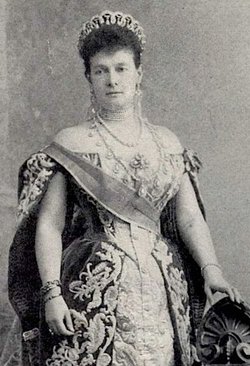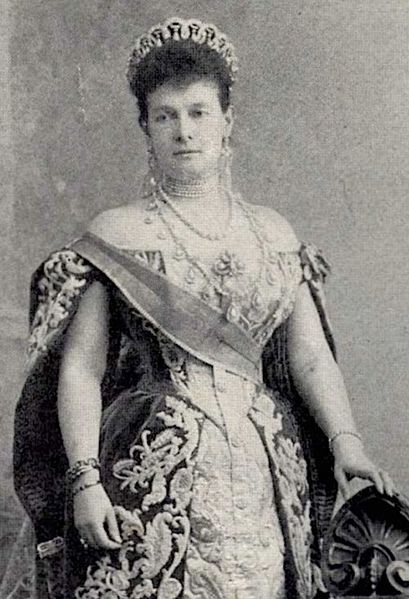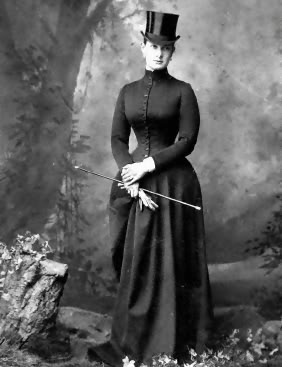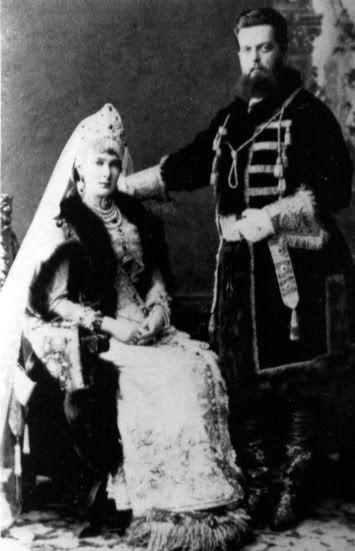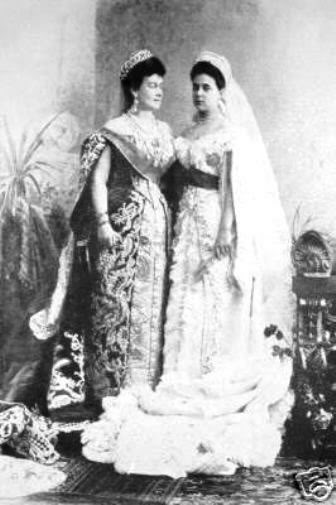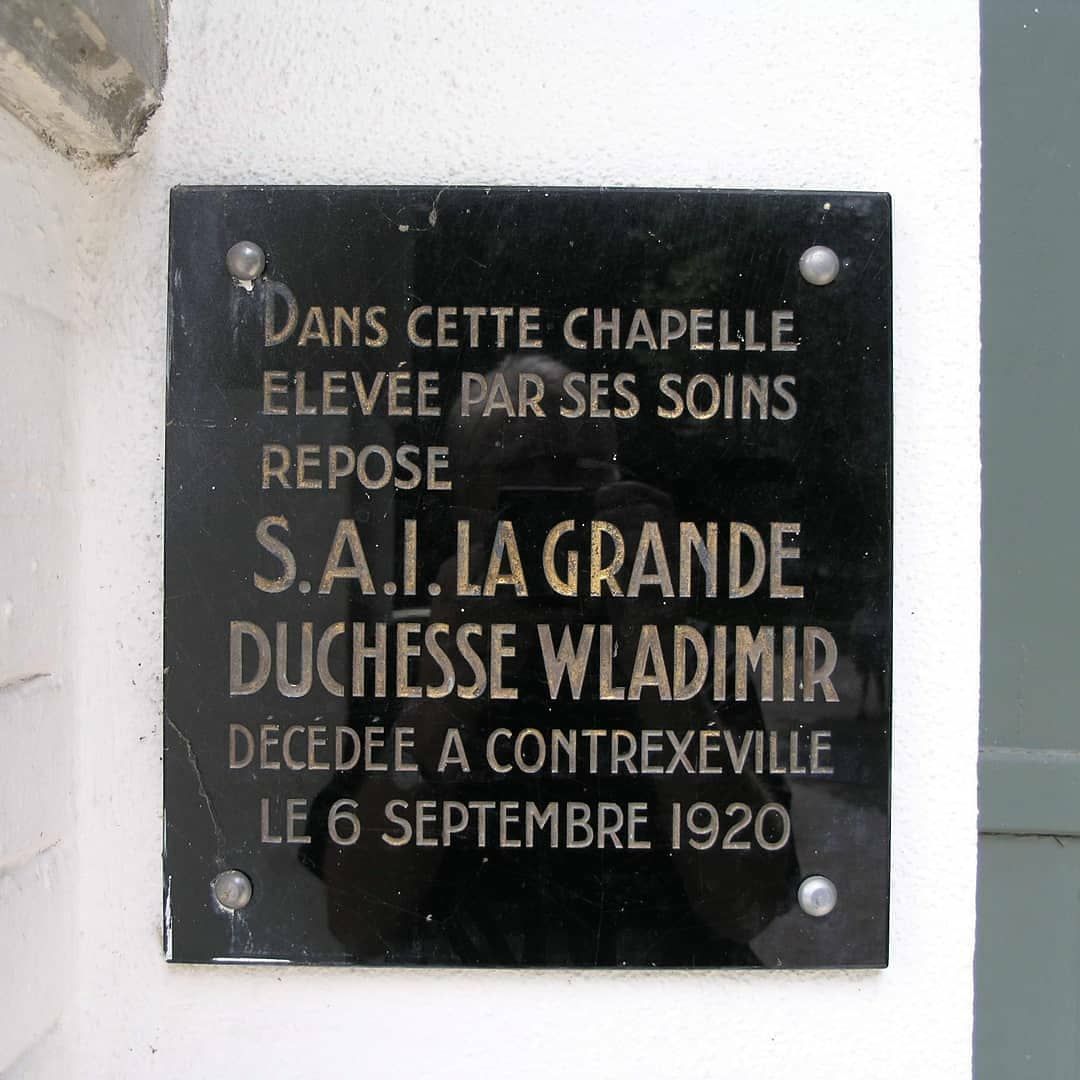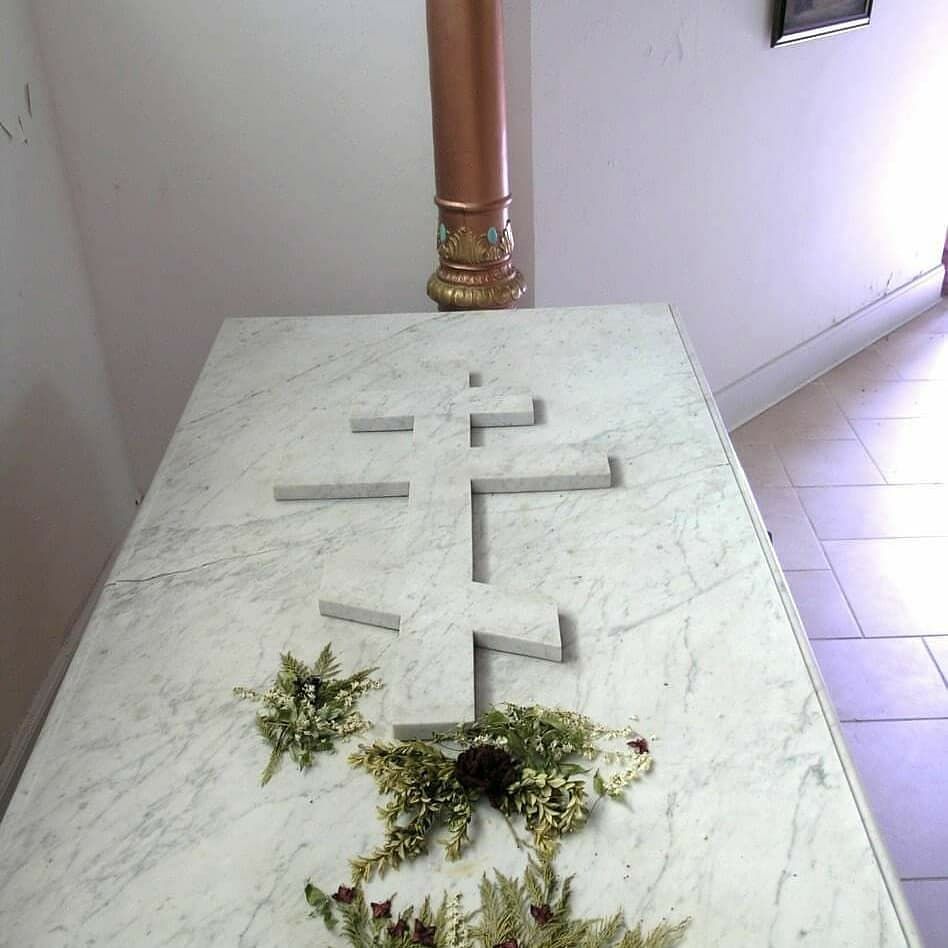~Life Before Russia
Marie Alexandrine Elisabeth Eleonore von Mecklenburg-Schwerin was born a duchess of the Grand Ducal House of Mecklenburg to Frederick Francis II, Grand Duke of Mecklenburg-Schwerin - the then Grand Duke of Mecklenburg -Schwerin and his first wife, Princess Augusta of Reuss-Köstritz (1822–1862) - in the Schloss Ludwigslust.
Her mother died in 1862 when Marie was 8 years old. Her father married again twice.
~Marriage & Children
She married the third son of Alexander II of Russia, Grand Duke Vladimir Alexandrovich of Russia (22 April 1847 – 17 February 1909) on 28 August 1874, being one of the very few princesses with Slavic patriline to ever marry a male dynast of the Holstein-Gottorp-Romanov. She had been engaged to someone else, but broke it off as soon as she met Vladimir. It took three more years before they were permitted to marry. Raised as Lutheran, she refused to convert to the Russian Orthodox Church.
Tsar Alexander II finally agreed to let Vladimir marry her without insisting on her conversion to Orthodoxy.[2] Upon her marriage she took the Russian name of Maria Pavlovna of Russia - the name she is best known by. Maria remained Lutheran throughout most of her marriage, but converted to Orthodoxy later in her marriage, some said to give her son Kirill a better chance at the throne. As a result of marrying a son of an Emperor of Russia, she took on a new style; Her Imperial Highness as her husband did; The Grand Ducal couple had four sons and one daughter:
Grand Duke Alexander Vladimirovich of Russia (31 August 1875 – 16 March 1877)
Grand Duke Cyril Vladimirovich of Russia (12 October 1876 – 12 October 1938)
Grand Duke Boris Vladimirovich of Russia (24 November 1877 – 9 November 1943)
Grand Duke Andrei Vladimirovich of Russia (14 May 1879 – 30 October 1956)
Grand Duchess Elena Vladimirovna of Russia.[3] (17 January 1882 – 13 March 1957) She married Prince Nicholas of Greece and Denmark.
All of Maria's children were born at the Catherine Palace, Tsarskoye Selo apart from her third child Boris who was born in St Peteresburg. Maria Pavlovna's eldest son Grand Duke Cyril Vladimirovich of Russia married, in 1905, his first cousin Victoria Melita of Saxe-Coburg and Gotha, daughter of Vladimir's sister the Duchess of Edinburgh and of Saxe-Coburg and Gotha. This marriage was disapproved by Nicholas II and Cyril was stripped of his imperial titles. The treatment of her son created a strife between her husband and the Emperor. However, after several deaths in the family put Cyril third in the line of succession to the Imperial Throne, Nicholas agreed to reinstate Cyril's Imperial titles, and the latter's wife was given the title Grand Duchess Viktoria Fedorovna.
~Life in Russia
During her life in Russia, Maria Pavlovna lived at her husband's beloved Vladimir Palace situated on the famously aristocratic Palace Embankment on the Neva River. It was there that she established her reputation as being one of best hostesses in the capital. It was often joked that she would deliberately try to outdo the Imperial Court at the nearby Winter Palace. She was also said to have been in competition with her sister-in-law Grand Duchess Elizabeth Feodorovna of Russia - sister of Alexandra Feodorovna.
In her own way, Maria Pavlovna was mentally imbalanced as was her full brother Paul Frederick: both were sort of out of touch with reality, Maria in her ambition but also in her extravagant ways (her husband had immense wealth, so she was not even near bankruptcy) though not as her poverty-stricken wastrel brother.
She was considered the grandest of the Grand Duchesses, and formed an alternate court in the later years of the reign of her nephew Nicholas II. The Grand Duchess hated The Tsar and Tsarina towards the end of the dynasty (especially the Tsarina). Along with her sons, she contemplated a coup against the Tsar in the winter of 1916–1917, that would force the Tsar's abdication and replacement by her son, Grand Duke Kirill as regent. In seeking support for the coup, she famously told Duma president Mikhail Rodzianko that the Empress, must be "annihilated."
In 1909, her husband died and she succeeded him as president of the Academy of Fine Arts.
~Escape From Russia
The Grand Duchess held the distinction to be the last of the Romanovs to escape Revolutionary Russia as well as the first to die in exile. She remained in the war-torn Caucausus with her two younger sons throughout 1917 and 1918, still hoping to make her eldest son Kirill Vladimirovich the Tsar. As the Bolsheviks approached, the group finally escaped aboard a fishing boat to Anapa in 1918. Maria spent fourteen months in Anapa, refusing to join her son Boris in leaving Russia.
When opportunities to escape through Constantinople presented themselves she still refused to leave for fear she would be subjected to the indignity of delousing. She finally agreed to leave when the general of the White Army warned her that his side was losing the civil war. Maria, her son Andrei, Andrei's mistress Mathilde Kschessinska, and Andrei and Mathilde's son Vladimir (Vova), boarded an Italian ship headed to Venice on 13 February 1920. Grand Duchess Olga Alexandrovna of Russia encountered Maria at the port of Novorossik in early 1920: "Disregarding peril and hardship, she stubbornly kept to all the trimmings of bygone splendour and glory. And somehow she carried it off . When even generals found themselves lucky to find a horse cart and an old nag to bring them to safety, Aunt Miechen made a long journey in her own train. It was battered all right--but it was hers. For the first time in my life I found it a pleasure to kiss her.
Maria made her way from Venice to Switzerland and then to France, where her health failed. Staying at her villa (nowthe Hôtel la Souveraine), she died there on 6 September 1920, surrounded by her family at Contrexéville. With the help of a family friend, her renowned jewel collection was smuggled out of Russia in a diplomatic bag. One of her tiaras is today owned by Queen Elizabeth II. At her death her famous collection of jewels were divided up between her children; Grand Duke Boris gained the emeralds, Grand Duke Cyril gained her pearls, Andrei got her rubies and her only daughter Elena received her diamonds. A batch of cufflinks and cigarette cases were found yet in 2008 in the archives of the Swedish foreign ministry. She deposited them at the Swedish Embassy in Saint Petersburg before she fled.
~Bio From Wikipedia
~Life Before Russia
Marie Alexandrine Elisabeth Eleonore von Mecklenburg-Schwerin was born a duchess of the Grand Ducal House of Mecklenburg to Frederick Francis II, Grand Duke of Mecklenburg-Schwerin - the then Grand Duke of Mecklenburg -Schwerin and his first wife, Princess Augusta of Reuss-Köstritz (1822–1862) - in the Schloss Ludwigslust.
Her mother died in 1862 when Marie was 8 years old. Her father married again twice.
~Marriage & Children
She married the third son of Alexander II of Russia, Grand Duke Vladimir Alexandrovich of Russia (22 April 1847 – 17 February 1909) on 28 August 1874, being one of the very few princesses with Slavic patriline to ever marry a male dynast of the Holstein-Gottorp-Romanov. She had been engaged to someone else, but broke it off as soon as she met Vladimir. It took three more years before they were permitted to marry. Raised as Lutheran, she refused to convert to the Russian Orthodox Church.
Tsar Alexander II finally agreed to let Vladimir marry her without insisting on her conversion to Orthodoxy.[2] Upon her marriage she took the Russian name of Maria Pavlovna of Russia - the name she is best known by. Maria remained Lutheran throughout most of her marriage, but converted to Orthodoxy later in her marriage, some said to give her son Kirill a better chance at the throne. As a result of marrying a son of an Emperor of Russia, she took on a new style; Her Imperial Highness as her husband did; The Grand Ducal couple had four sons and one daughter:
Grand Duke Alexander Vladimirovich of Russia (31 August 1875 – 16 March 1877)
Grand Duke Cyril Vladimirovich of Russia (12 October 1876 – 12 October 1938)
Grand Duke Boris Vladimirovich of Russia (24 November 1877 – 9 November 1943)
Grand Duke Andrei Vladimirovich of Russia (14 May 1879 – 30 October 1956)
Grand Duchess Elena Vladimirovna of Russia.[3] (17 January 1882 – 13 March 1957) She married Prince Nicholas of Greece and Denmark.
All of Maria's children were born at the Catherine Palace, Tsarskoye Selo apart from her third child Boris who was born in St Peteresburg. Maria Pavlovna's eldest son Grand Duke Cyril Vladimirovich of Russia married, in 1905, his first cousin Victoria Melita of Saxe-Coburg and Gotha, daughter of Vladimir's sister the Duchess of Edinburgh and of Saxe-Coburg and Gotha. This marriage was disapproved by Nicholas II and Cyril was stripped of his imperial titles. The treatment of her son created a strife between her husband and the Emperor. However, after several deaths in the family put Cyril third in the line of succession to the Imperial Throne, Nicholas agreed to reinstate Cyril's Imperial titles, and the latter's wife was given the title Grand Duchess Viktoria Fedorovna.
~Life in Russia
During her life in Russia, Maria Pavlovna lived at her husband's beloved Vladimir Palace situated on the famously aristocratic Palace Embankment on the Neva River. It was there that she established her reputation as being one of best hostesses in the capital. It was often joked that she would deliberately try to outdo the Imperial Court at the nearby Winter Palace. She was also said to have been in competition with her sister-in-law Grand Duchess Elizabeth Feodorovna of Russia - sister of Alexandra Feodorovna.
In her own way, Maria Pavlovna was mentally imbalanced as was her full brother Paul Frederick: both were sort of out of touch with reality, Maria in her ambition but also in her extravagant ways (her husband had immense wealth, so she was not even near bankruptcy) though not as her poverty-stricken wastrel brother.
She was considered the grandest of the Grand Duchesses, and formed an alternate court in the later years of the reign of her nephew Nicholas II. The Grand Duchess hated The Tsar and Tsarina towards the end of the dynasty (especially the Tsarina). Along with her sons, she contemplated a coup against the Tsar in the winter of 1916–1917, that would force the Tsar's abdication and replacement by her son, Grand Duke Kirill as regent. In seeking support for the coup, she famously told Duma president Mikhail Rodzianko that the Empress, must be "annihilated."
In 1909, her husband died and she succeeded him as president of the Academy of Fine Arts.
~Escape From Russia
The Grand Duchess held the distinction to be the last of the Romanovs to escape Revolutionary Russia as well as the first to die in exile. She remained in the war-torn Caucausus with her two younger sons throughout 1917 and 1918, still hoping to make her eldest son Kirill Vladimirovich the Tsar. As the Bolsheviks approached, the group finally escaped aboard a fishing boat to Anapa in 1918. Maria spent fourteen months in Anapa, refusing to join her son Boris in leaving Russia.
When opportunities to escape through Constantinople presented themselves she still refused to leave for fear she would be subjected to the indignity of delousing. She finally agreed to leave when the general of the White Army warned her that his side was losing the civil war. Maria, her son Andrei, Andrei's mistress Mathilde Kschessinska, and Andrei and Mathilde's son Vladimir (Vova), boarded an Italian ship headed to Venice on 13 February 1920. Grand Duchess Olga Alexandrovna of Russia encountered Maria at the port of Novorossik in early 1920: "Disregarding peril and hardship, she stubbornly kept to all the trimmings of bygone splendour and glory. And somehow she carried it off . When even generals found themselves lucky to find a horse cart and an old nag to bring them to safety, Aunt Miechen made a long journey in her own train. It was battered all right--but it was hers. For the first time in my life I found it a pleasure to kiss her.
Maria made her way from Venice to Switzerland and then to France, where her health failed. Staying at her villa (nowthe Hôtel la Souveraine), she died there on 6 September 1920, surrounded by her family at Contrexéville. With the help of a family friend, her renowned jewel collection was smuggled out of Russia in a diplomatic bag. One of her tiaras is today owned by Queen Elizabeth II. At her death her famous collection of jewels were divided up between her children; Grand Duke Boris gained the emeralds, Grand Duke Cyril gained her pearls, Andrei got her rubies and her only daughter Elena received her diamonds. A batch of cufflinks and cigarette cases were found yet in 2008 in the archives of the Swedish foreign ministry. She deposited them at the Swedish Embassy in Saint Petersburg before she fled.
~Bio From Wikipedia
Family Members
Sponsored by Ancestry
Advertisement
Advertisement
